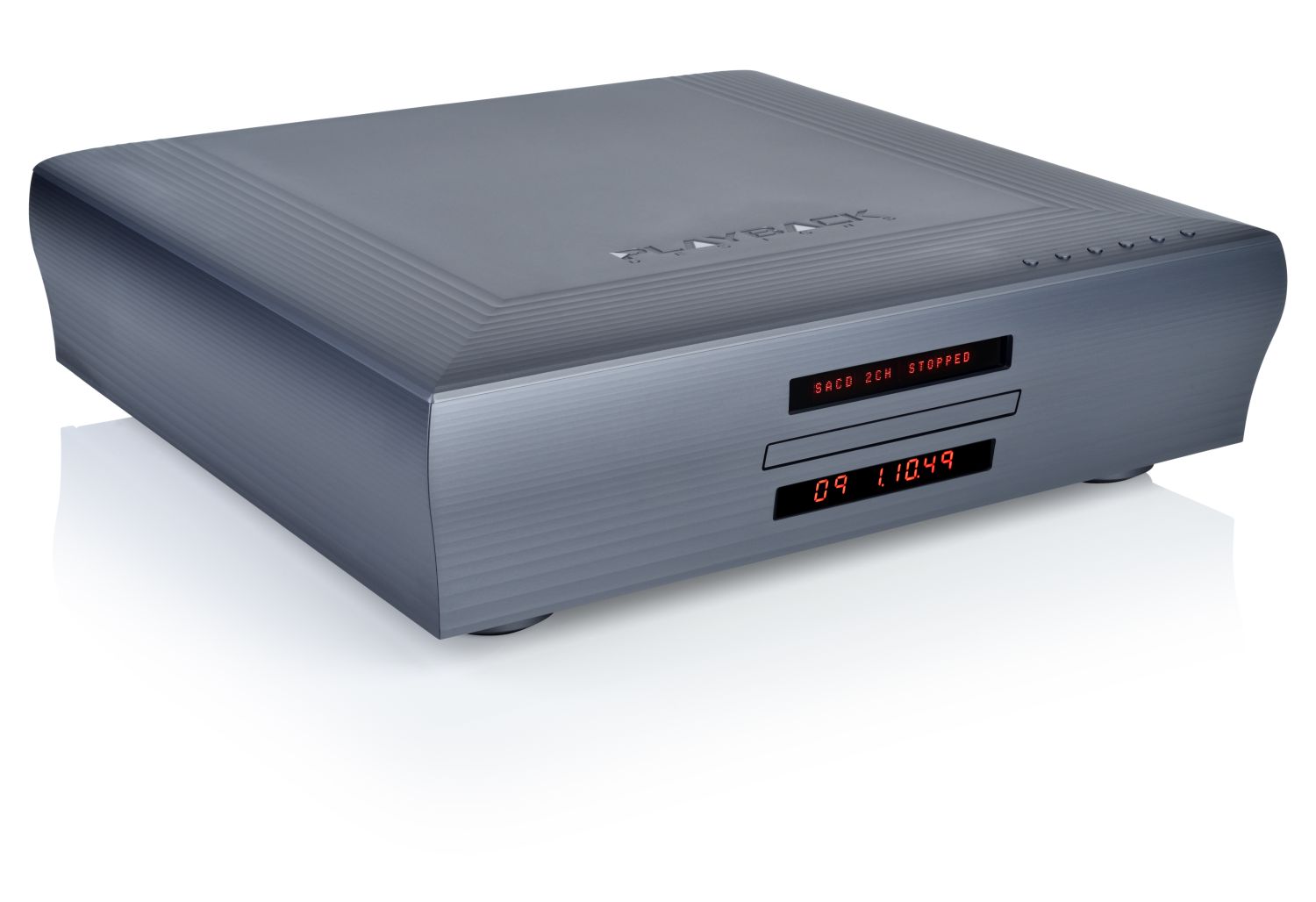Meridian Sooloos MD600 and MS600
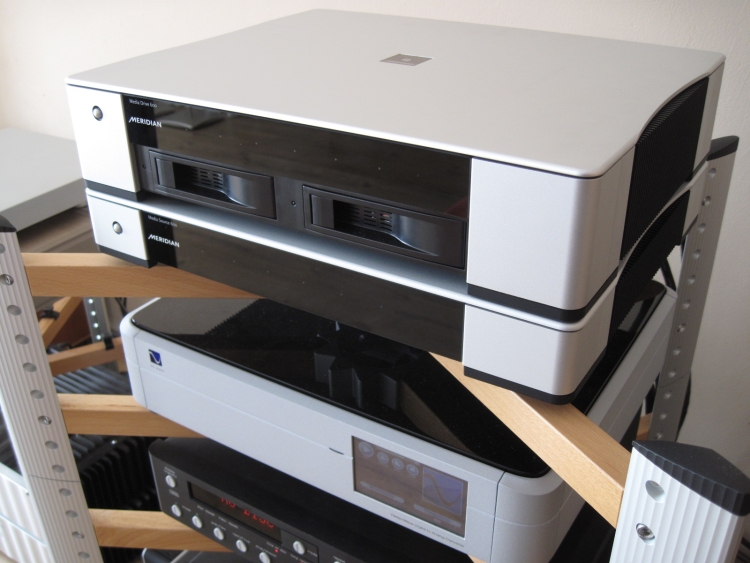
After being so enthusiastic about the MC200 and almost having purchased one, I decided to first review its bigger brothers
The MD600 takes responsibility for storage and control. The MS600 is the G-series top zone player. Outside and inside it is an all-new, pure Meridian design. Would these babies make a very large difference? Naturally, I was expecting some difference, but not hugely so. Oh, how wrong I was…
Review samples kindly supplied by Dutch distributor Viertron
Retail price MD600 3500 euro
Retail price MS600 2450 euro
Note: the Sooloos name has now changed into “Meridian Streaming Audio”.
Because the MD600/MS600 pair functions almost exactly like the MC200, I have copied the text detailing my experiences with the super-slick Sooloos interface from that review below, with modifications and additions where applicable.
Background
Regular readers know that I don’t usually spend much time discussing the operability and options of any device, and instead go straight to the listening tests. After all, that is what interests me most. In this case, I need to make an exception to this routine because the Sooloos system is all about functionality and user-friendliness. The Sooloos system sets the benchmark for intuitive control over your music collection so extremely high, that it just creates an enormous gap between it and all other network-audio products that I have tested thus far. So, what makes the Sooloos system so special?
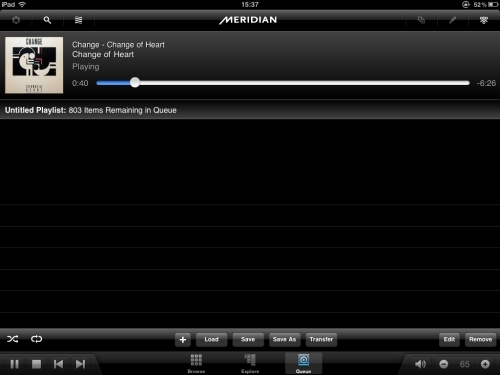
For starters, that it is not your typical UPnP streamer. In fact, it’s not a streamer at all. Instead, think of the MD600 as a dedicated audio server. The MD600 unit itself can be seen as a NAS, offering the same sort of functionality but centered only on audio. You cannot connect external hard drives or a NAS to the MD600. You can however add as many zones and extra disk space as you want, the latter can be any Sooloos device as long as they’re configured to allow only one to be the Core. The MD600 can send separate audio streams to many zones simultaneously, or send closely synced music to all zones simultaneously. For that to work all that’s needed is to install the freely available ControlPC or ControlMac software. This software allows access to all import and export settings as well as full database access and playback, even controlling playback to other zones. What is most distinctive however is the way that you navigate through your collection. It lightly resembles iTunes in the way that you swipe left and right with extremely smooth movement. Naturally, you can just browse the directory as it exists for example artist folder containing album folder containing tracks, or go by album, by artist or by song, but it goes so much further than that.
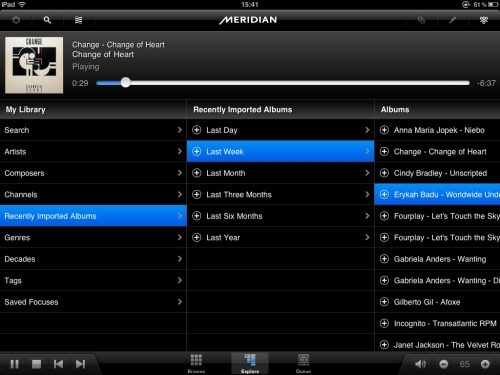
You can also browse through recently imported items, last day, last week etc. Then there’s the very capable search functionality: free search, artist search, album search, tag search etc, and this also works if you type “Johnson” if you’re looking for Don Johnson. No need to start with the first letter. But there’s much, much more. When you import a CD, it is automatically compared against a database that not only contains the usual tags such as artist, album and track titles, it also adds tags such as “producer”, “musicians”, “writers”, and moods such as “positive”, “contemplative” or “easy”. It even collects a review if it is available. If wanted you can also add unlimited tags of your own. All these attributes can then be searched for. Once a match is found, you are automatically presented with all this info, as well as more albums from the same artist. From there you can choose to play the entire search result, only select albums or single tracks: right now, after the current track, or at the end of the current playlist.
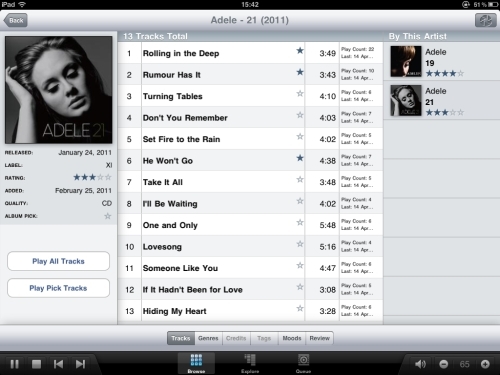
You can also save a “focus” from the results, or even on a combination of some of the attributes while adding more rules which make matches with other tags, and play right away or save the results for later. From this focus you can then choose to make a playlist or just shuffle through it, called “swim” in Meridian lingo. Swim works much in the way that Wincue works for Winamp: whenever your playlist runs out, it will auto cue another track either randomly, or from a set of rules. Meridian even goes a step further, allowing a playlist with a mix of defined order and swimming in-between. For example, when you are listening to a playlist and hear something you like, you can search for other music like it, and select “swim in this artist”. The MD600 will then play all the tracks by this artist (or a selection if you have track picks, or track deletions) and once done, resume with the rest of the playlist.
The MS600 is very straightforward: it simply serves to decode the digital stream that it receives from the MD600, or from any other Core-enabled Sooloos device in the network.
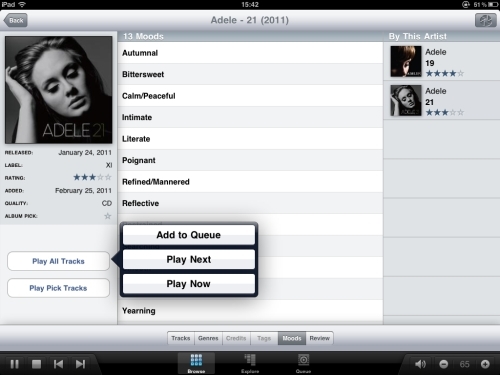
What’s more, even though WAV files normally don’t contain tags, the MD600’s internal database takes care of that, making WAV files appear precisely the same as FLAC or any other fully-tagged format once you look them up in the Sooloos library. I haven’t gone all the way describing the extended functionality, but it should be obvious by now that the navigation is simply state of the art.
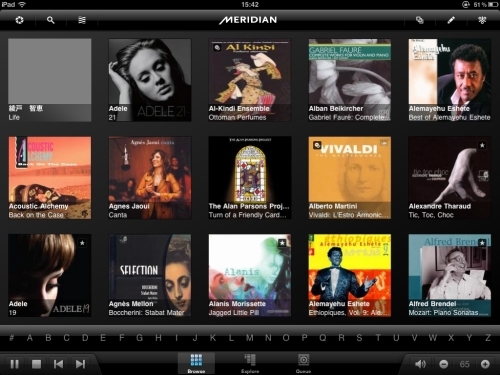
Oh, one more thing: connectivity is utterly stable and entirely problem-free. Connect to the network and the Core Control utility for iPad will find the MD600 and MS600 within seconds every time. How different from the Linn Klimax that frequently needs a restart after the network cable has been swapped, or the PS Audio PWD, that always goes through a routine of keeping me waiting for a long period before it finds the connection, only to drop it 5 times after that, before becoming stable. Other manufacturers take note: this is how it should be done!
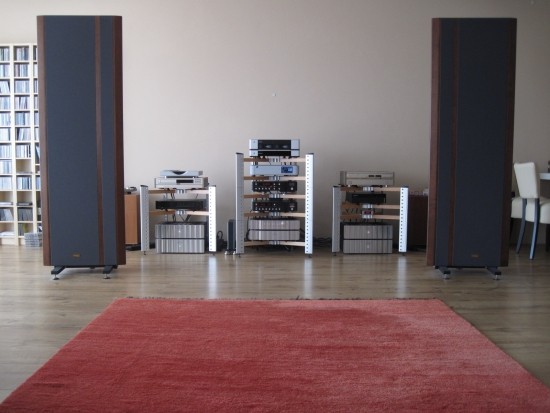
Setup
Just like with the MC200, there’s a setting where you can choose ‘force 1x sample rate’. Unlike with the MC200, this isn’t done in the Sooloos Config application for Windows, but simply by navigating to the unit’s IP address using any regular internet browser. The ‘force 1x sample rate’ setting forces the MS600 to play the various files in their native sample rate, which is 44.1 for CD’s. Disabling the option makes the unit upsample 44.1 to 88.2 but leaving high res files untouched. This upsampling is done by means of Meridian’s proprietary apodizing filter, and for me this setting produces a much better sound. Bass becomes fuller, midrange richer, treble more fluid and soundstage wider. The only thing that could count in favor of 1x sample rate is that the bass is slightly tighter and the transients slightly sharper. But for me that is no argument, because a smidgeon forgiveness is never bad in a digital component, plus I quite like my music presented rich and full, and the MD600/MS600 combo sounds plenty fast and tuneful when upsampling to 88.2 khz. This is the factory default so my advice would be not to touch it.
Because I knew that the MC200 was sensitive to power cables, in spite of its external switching power supply, I used the best cables I have for the MD600/MS600 combo right from the start. I was so impressed with the resultant sound that I never tried other cables, except for the standard cable (supplied with the unit) when the MD600 was setup in another room. More on that further below.
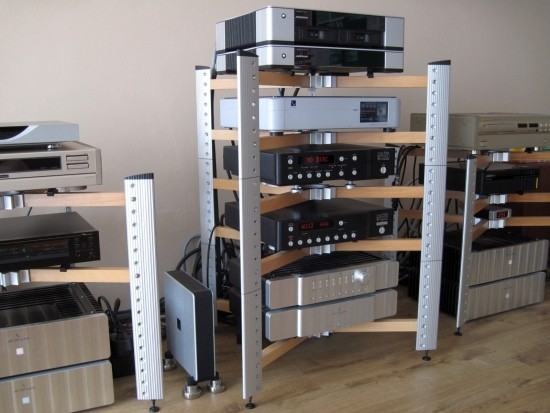
Sound
From the moment that I connected the units and started listening, I didn’t switch sources for over two weeks. Such was the rightness of the music that I just didn’t feel the need to. Naturally, the units had some running in to do, as was clear from the initial brightness and slight aggression in the treble. But having had multiple Meridian separates, I knew that there was no way that a Meridian would ever sound aggressive by design. And indeed the MD600/MS600 combo’s sound started to bed in after a day or two, with slow improvements after that. I don’t know for sure when the system started singing at its best, but I’d wager that it was after a week when I didn’t consciously hear improvements anymore.
The initial setup was the two units stacked on top of each other, on top of the Spider rack. I fed the MD600 with a Lapp cable with gold plated IeGO connectors and the MS600 with a Furutech Alpha 3 cable with gold plated Furutech FI25/FI35 connectors. Both were connected to the same ethernet switch that is located right behind the system. There’s a lot I discovered about this particular aspect, but more on that later. Naturally, I connected the MS600 with balanced Cardas Hexlink Golden 5C interlinks, given the balanced nature of my setup.
Without comparing the first aspect of the sound that stood out was the ambiance. No matter what you played, there was always a nice atmospheric quality to the music. Also evident is the treble smoothness and air. Another thing I noticed was the bass, which was slightly rounded but very deep and full, yet nimble and fast. While I love the Wadia-type bass, this normally goes hand in hand with a more stringent character throughout the midrange and treble and because I am allergic to treble dryness, I can live with a slightly rounded bass. What’s more: it makes for a more forgiving sound that is more tolerant toward less well-recorded CDs. That, and both Levinsons (390S and 360S) both have this characteristic too.
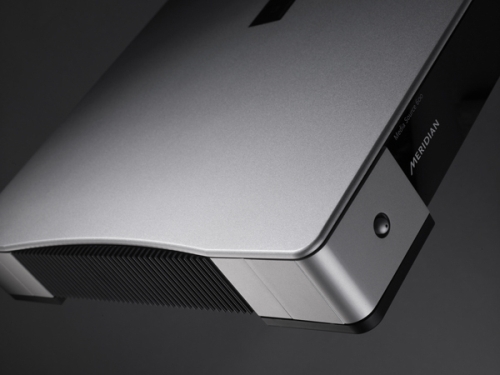
First comparisons
Three weeks in I made the first comparisons to the Levinson 390S cd player. While the MC200 sounded very un-digital and quite a bit like my 390S, as long as the MC200 was used with the Levinson 360S DAC, the MD600/MS600 combo managed to achieve this using its own inbuilt DAC, which was very surprising. Actually, in some respects, the Sooloos combo even sounded better than the 390S. This was in terms of pacing, transparency and communication. Yet the combo never sounds clinical or technical, or even remotely computer-like. Nope, it simply sounds wholly musical and highly engaging. The Levinson sounds a smidgeon fuller in the bass and is a little more forgiving, but you could also say that it sounds overly smooth. Switching between the 390S and the Meridian combo, I could find favor for both approaches, and both are equally valid and equally enjoyable. The PS Audio has a different approach: it is tighter, drier and more strict, but also very communicative. But what’s interesting is to note that while I formerly thought the PWD to be unbeatable in soundstaging, the Meridian combo turns out to almost equal it in terms of focus and definition, and even beat it in terms of spaciousness and room-filling ability. Lastly, the PWD’s Achilles heel is its treble, which is a bit rough and lacks some air. Here the Meridian combo clearly takes the lead, with smooth, extended and highly refined treble.
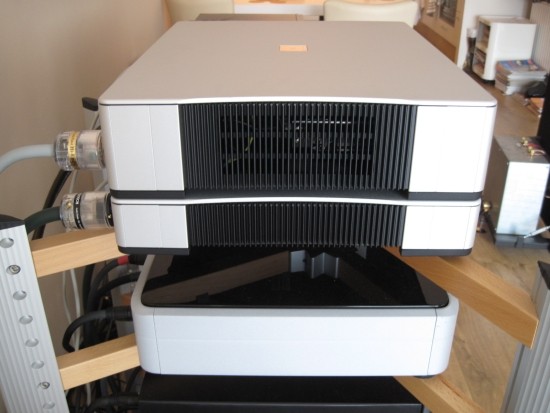
Above: Air outlet on the left-hand side. The inlet with the fan is on the right-hand side. Obvious is the absence of screws. In true Meridian tradition, these are all nicely moved out of sight.
Closer listening
After a month I ran some more extensive comparisons: alone and with several friends on several occasions. For this, the setup was still identical as described above. Time and again it was evident that the MD600/MS600 painted a very large, very atmospheric image and was never aggressive, dry, clinical or any of those things that you normally associate with computer audio replay. Even hardcore non-computer audiophile friends were impressed with how non-computer-like the combo sounded.
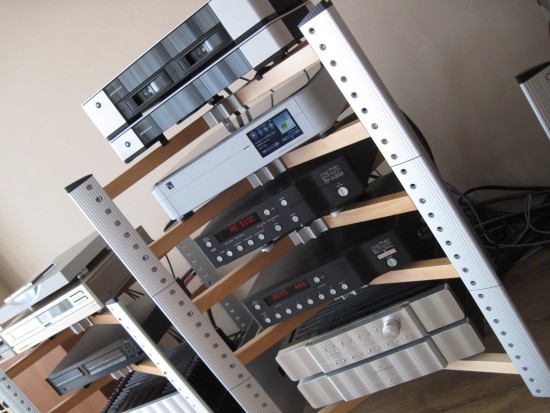
Compared to Levinson 390S CD player
After the first switch, our suspicions were confounded: indeed the 390S and the MD600/MS600 combo shared many similarities. Both have deep and full bass that is slightly rounded and relaxed, yet fast and rhythmic; both are a smidgeon rounded on the transients; both sound full and warm and have smooth, fluid, extended treble. Now for the differences: the Meridian combo was somewhat faster, better paced. Also, the combo was more transparent and appeared to have better articulation throughout the frequency band, but without ever sounding dry or analytical. Lastly, the combo had even better soundstaging than the Levinsons. The Levinson in turn was more free-flowing, more ethereal, still a bit smoother and also a little richer throughout the midband, although it could also be said to be a little too laidback and lacking some focus.
Compared to Meridian 506.24 CD player
While I had thought that the MD600/MS600 combo would sound a lot like the 506.24, a direct comparison made clear that this wasn’t quite the case. The 506.24 is an exceptional player, in that it is the uttermost smooth and fluid-sounding Meridian player that I know. Its predecessor the 506.16, as well as its follow-up the 507, sound a lot tighter and faster. In fact you could say that the 506.24, like the Levinson, is a bit too mellow, but it is also very musical and with the right music can be highly relaxing. But I wouldn’t rate it as highly as the MD600/MS600 combo for the latter are more transparent and have better PRAT and simply sound better with a wider range of music. From memory, I would say that the Sooloos pairing sounds more like the famous 508.24 cd player, only fuller and richer still.
Compared to PS Audio PWD
This was a weird experience. Before I had proclaimed the PS Audio PWD MKII to have the absolute best soundstaging capabilities of all machines I ever heard, Wadia’s 861 and S7i included. But compared to the Sooloos pair, it wasn’t that impressive anymore, because the Sooloos units managed to sound just as large and wide, and focus just as well as the PWD. The only difference was in the lateral layering, where the PWD had better differentiation. Moving on to other aspects of the sound, the PWD did sound more articulate from top to bottom. But while this was nice at the bottom end, it was less welcome in the treble, which is somewhat coarse and dry with the PWD. But that is the only wrongdoing of this unit as far as I am concerned and otherwise it can be regarded as the MD600/MS600’s equal. These are just two different approaches: the PWD being more precise and more differentiated dynamically, the Meridians being warmer and more fluid. This comes down to taste and both are equally valid.
Compared to the Linn Klimax DS/0
The Linn is still on top in terms of resolution and micro detailing. But while it may be the most refined source I have, this doesn’t necessarily translate directly into a musically more engaging delivery. It is interesting to discover that the mind and the heart can have opposite feelings. Technically the DS/0 is superior, and its DS/1 followup even more so. But emotionally (musically speaking) the Klimaxes do not move me any more than the Meridian combo does. What’s more, the MD600/MS600 combo manages to sound bigger and bolder, more energetic and lively, even more dynamic than the DS/0, while sounding almost as fluid and refined in the treble. The latter is always very important for me and importantly, the MD600/MS600 pair has lots of air and absolutely grain-free treble.
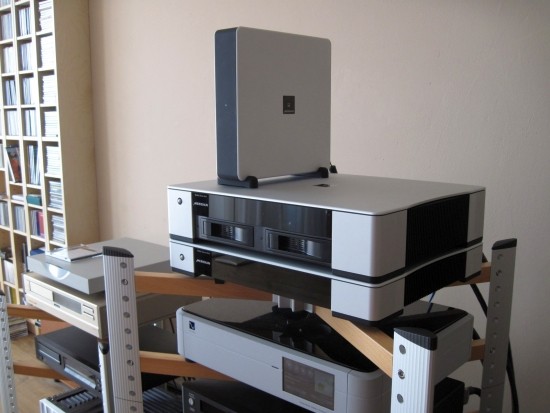
Compared to the MC200
Again here was a weird experience. While I wasn’t entirely convinced by the MC200’s analog outputs, I was quite taken by its sound using a Levinson 360S dac. But the MD600/MS600 using the MS600’s analog outputs simply outclass the MC200/360 combo in every aspect. Bigger, deeper, more powerful bass, a richer, more colorful midrange and smoother, more fluid, and -importantly, more open and airy treble.
But I have to give advanced warning that it will now get even weirder. It was at this stage that I wanted to know exactly which component did what. Was the MS600 the one and only responsible for this result? Or did the MD600 also contribute? What would happen if I swapped the MD600 for the MC200, using it only as music tank and control unit?
Disconnecting the MD600 and attaching the UTP cable to the MC200, which was sitting on top of the MD600 at that time, being fed by the same type Lapp cable, the sound at first seemed quite similar, but it only took 10 seconds for us to realize that in fact it was a lot different! The bass was thinner and lacked power and substance, the midrange had lost its glorious timbre and richness and the treble was now darker and drier. I know – it shouldn’t be and it couldn’t be. But we both heard it. For form I also tried the MC200’s analog outputs using the same Cardas Hexlink Golden 5C XLR cable, now using Cardas cinch to XLR adapters and although it wasn’t bad, definitely again quite the sound lost a lot of fullness, richness, dimensionality and musicality. Incidentally, the MC200’s treble darkness was evident both on its analog and digital outputs, but this wasn’t the case with the MD600/MS600, although weirdly enough the MC200’s treble darkness was also carried on through the MS600.
Then it was time to set up the MD600 on its final position: far away from the listening room, in another room. I had already prepped its position with a standard power cable and a standard UTP cable. Connected up and operational in well under 60 seconds, we couldn’t believe our ears at how much more mediocre it now sounded. In fact this combination reminded us of how the MC200 had sounded moments before. Gone was the full bass and gloriously rich midrange, in their place thin (albeit still fast) bass, bleached out midrange and narrow soundstaging. We restored the old setup to be absolutely sure but – sigh or relief – there it was again, the sound that I enjoyed so much. This was a bummer because the MD600 is all but silent. In fact, I can hear its 7cm fan from my bedroom which is at the other side of the apartment. OK I have no doors but still. Also, the enterprise-rated hard disks may be very reliable, they’re also a lot noisier than Samsung or WD Green types. But I understand from Meridian that you should avoid using disks that can fall asleep after a while because the system isn’t expecting that and it could cause problems.
Switches galore
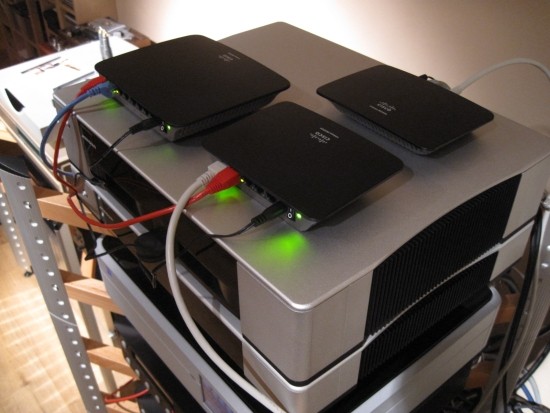
Digital is digital, right? We all thought so with respect to SP/Dif and this turned out not to be so clearly cut out. Now the same thing is said about TCP/IP. It couldn’t matter because jitter has been taken out of the equation because we’re now moving packets, not an audio stream. Still, as it so turns out, it matters.
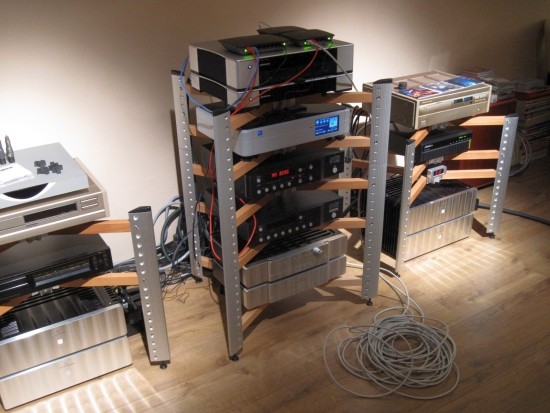
Still somewhat in disbelief, we decided to return the MD600 to the second room but use a Lapp powercable, connected straight to the wall outlet. Well yes, this did relax the midrange, and brought back some bass fullness, but it still wasn’t the same as when the components were stacked on top of each other. The only real difference was that the MD600 was now communicating with the MS600 through 3 different switches. Then we decided to do the ultimate test. The MD600 was left in its position, on top of the MS600 and fed with the same Lapp powercable, but this time we re-routed the UTP signal through 3 newly bought gigabit switches with various lengths of cable between them, the longest being 20 meters. And there you had it: again it sounded like it had done when setup in the other room: thinned out, bleak, gray, neutral and uninvolving. All the bass fullness was gone and the midrange now even sounded aggressive at times.
We took the whole experiment a little further still by swapping the MD600 and MS600’s positions. Now the MS600 was on top. While that normally means airier treble and more nimble bass, in this case it was a little too much of a good thing. It seemed that the weight of the MD600 on top of the (slightly lightweight) MS600 was responsible for the fuller bass and more relaxed midrange. So I moved the units back into their old place and listened again, confirm: the sound was back. Then I moved the MD600 from the real Spider rack (and on top of the MS600) to the lower E&T spider rack. Lo and behold: the sound was still good, but lacked some drive and power. Our jaws were on the floor for some time already, but this really did us in. The friend in question is a network engineer. He knows how transport layers work in UDP/TCP/IP connections and he also knows that in theory, the sound could not be influenced by the addition of switches. If anything, they should improve the sound because they perform some sort of reclocking. We were simply dumbfounded. But the results spoke for themselves and there was no way that I was going to separate the Sooloos combo after this. I will have to find a way to silence the MD600 and live with it in the listening room.
Update November 2016:
I found an interesting piece of info by a Roon employee on the Roon forum:
“Meridian Audio discovered that RF, picked up by the Ethernet cable, could get into its product (ID40 card) and was unambiguously audible. In fact, they heard the difference first and it took them ages to realize that the audio quality improved when the Ethernet cable was removed. They then worked around the problem, initially in the Anniversary 808 by using RF suppressors on the cables, and subsequently with the development of the ID41 card which has much better E/M isolation”.
So far the quote from the Roon forum, I’ll rest my case by adding that the audio signal itself could well be impervious to a cable’s influences, but that other mechanisms can still be at play that account for the perceived differences in sound. We like to think that we have mapped all there is to know on this matter but we are still learning. Now, back to the original review.
The MD600 may be seen as a bit pricey for what it is and upon looking at pictures from its insides you wouldn’t say that there is any reason why it would sound any different from the MC200, apart from the hard disk dimensions (laptop drive for the MC200 and twin full-size drives for the MD600), but it does. And the difference is not at all small. No, the difference is actually ridiculously large.


MD600/MS600 sidenotes
Unlike the MC200, the MD600 and MS600 cannot be configured via the Sooloos config tool for Windows. Instead, the MS600 can be configured by entering its IP address in an internet browser. Amongst other things, this allows setting the upsampling on or off. The MD600 doesn’t have any way for configuring as far as I can figure out. So far, all I know is that only Meridian can configure it remotely. This includes turning the Core on or off.
While the MC200 can be used with a super-affordable Microsoft Media Center-compatible IR receiver for use with the company’s MSR+ controller, the MD600’s USB ports do not carry a function according to the manual. The MS600 however does have an IR jack at the back, but this will only function using the optional 225 euro Meridian G12 Remote IR Sensor. Then, using the MSR+, you have control over previous/next track, volume and play/pause.
Generic Meridian Streaming Audio (formerly Sooloos) Sidenotes
The Sooloos system offers the absolute best user interface for streaming audio but like all software, it isn’t without flaws. Most annoying for me is the inability to add tags or album picks directly from the Album Info screen on the Core Control iPad app and some issues I have with importing anything other than complete CD’s.
Conclusion
In spite of the above-mentioned quirks and wishlist, the Sooloos experience still stands head and shoulders above everything else that I have tried. While the Sooloos interface offers much sleeker and much more versatile functionality than any other streamer currently on the market, there are some quirks and bugs. I feel that the Control:PC software needs some work. But remember that the software is free and that it is already quite an achievement to entirely bypass the Control:10 or Control:15 and still offer similar functionality. This is relatively new software and I’m sure that work is already being done while I’m writing this review.
The hardware however is as stable as can be and network connectivity is top-ranking, booting and connecting very quickly and very reliably. The connection between MD600, MS600 and iPad is never lost and I haven’t experienced a single crash on the hardware side. The only thing that will crash occasionally, is the Core Control app on the iPad, most likely due to an iPad-inherent memory problem. If a problem on the iPad arises, the solution is as simple as force-quitting the app and restarting it. This is done by double-clicking the home button, tapping and holding the Core Control app until it starts wiggling, then clicking the x.
The MD600/MS600 combo not only offers benchmark-setting operability and functionality but also sound quality all the way up there with the best, nicely coming in side by side with the similarly-priced PS Audio PWD MKII. While the Sooloos combo may not have the Linn Klimax DS’s ultimate resolution (DS/0 or DS/1), they are no slouch in that area either, offering even better detailing and focus than the Levinson 390s cd player. What’s more, the Sooloos pairing even beats the Levinson in terms of soundstage size and midrange palpability while offering similarly powerful and deep bass and offering treble that’s just as fluid and airy. The MD600/MS600 pairing is also supremely musical and never fails to stir the soul. Such is the fun of using the Core Control iPad interface, that you can’t help but to dive into your collection and keep finding new and interesting music that for whatever reason you totally forgot about. Combined with their sound quality they have the power to make me neglect the CD medium.
Sooloos is now Roon – try it for yourself, on any hardware of your choosing
Videos on the Hifi-Advice YouTube Channel
How Sooloos became Roon
HFA Front Page
